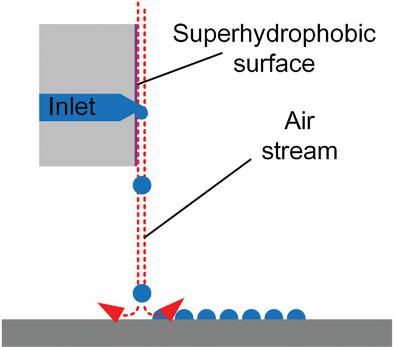当前位置:
X-MOL 学术
›
Adv. Mater. Interfaces
›
论文详情
Our official English website, www.x-mol.net, welcomes your feedback! (Note: you will need to create a separate account there.)
Pneumatic Conveying Printing Based on Super Hydrophobic Surface
Advanced Materials Interfaces ( IF 5.4 ) Pub Date : 2020-03-29 , DOI: 10.1002/admi.201902131 Dege Li 1 , Yi Cao 1 , Hang Dong 1 , Xinlei Wu 1 , Qiang Sun 1 , Chi Ma 1 , Bingfang Huang 1 , Shokoufeh Rastgar 2 , Gunther Wittstock 2 , Yonghong Liu 1 , Yanzhen Zhang 1, 2
Advanced Materials Interfaces ( IF 5.4 ) Pub Date : 2020-03-29 , DOI: 10.1002/admi.201902131 Dege Li 1 , Yi Cao 1 , Hang Dong 1 , Xinlei Wu 1 , Qiang Sun 1 , Chi Ma 1 , Bingfang Huang 1 , Shokoufeh Rastgar 2 , Gunther Wittstock 2 , Yonghong Liu 1 , Yanzhen Zhang 1, 2
Affiliation

|
In today's era, the inkjet printing (IJP) technique plays important roles in the fabrication of mechanical, electronical, and even biological devices. However, the current IJP techniques are incapable of handling viscous inks, which greatly hinder the extensive industrial application. Here, it is found that utilizing the superhydrophobic materials on the end surface of a nozzle combined with the dragging and shearing effects of an airflow, micrometer‐sized droplets can be generated under a quite low ejection/extrusion pressure. This variation of the traditional IJP technique is called pneumatic conveying printing (PCP) and is capable of handling viscous inks. Two PCP prototypes using micropump and micropiezo as the ink extruder, respectively, are homemade to demonstrate the printing performance. For the PCP using micropump inks with viscosities as high as several thousand mPa s can be printed. For the PCP using a micropiezo, the maximum allowed viscosity is about 700 mPa s. Furthermore, the pressure within the pipeline or ink chamber and the shear rate at the orifice during PCP are much smaller than those of the traditional IJP due to the slower ink extrusion rate. Both experiment and simulation are carried out to reveal the mechanisms of the proposed PCP technique.
中文翻译:

基于超疏水表面的气力输送印刷
在当今时代,喷墨打印(IJP)技术在机械,电子甚至生物设备的制造中起着重要作用。但是,当前的IJP技术无法处理粘性油墨,这极大地阻碍了广泛的工业应用。在这里,我们发现,利用喷嘴端面上的超疏水材料并结合气流的牵引和剪切作用,可以在相当低的喷射/挤压压力下产生微米级的液滴。传统IJP技术的这种变化称为气动输送印刷(PCP),并且能够处理粘性油墨。分别使用微型泵和微型压电泵作为油墨挤出机的两个PCP原型是自制的,以演示印刷性能。对于使用微型泵的PCP,其粘度可高达数千mPa s。对于使用微压电的PCP,最大允许粘度约为700 mPa s。此外,由于墨水挤出速度较慢,因此在PCP期间,管道或墨水腔内的压力以及孔口处的剪切速率比传统IJP的小得多。进行了实验和仿真,以揭示所提出的PCP技术的机理。
更新日期:2020-03-29
中文翻译:

基于超疏水表面的气力输送印刷
在当今时代,喷墨打印(IJP)技术在机械,电子甚至生物设备的制造中起着重要作用。但是,当前的IJP技术无法处理粘性油墨,这极大地阻碍了广泛的工业应用。在这里,我们发现,利用喷嘴端面上的超疏水材料并结合气流的牵引和剪切作用,可以在相当低的喷射/挤压压力下产生微米级的液滴。传统IJP技术的这种变化称为气动输送印刷(PCP),并且能够处理粘性油墨。分别使用微型泵和微型压电泵作为油墨挤出机的两个PCP原型是自制的,以演示印刷性能。对于使用微型泵的PCP,其粘度可高达数千mPa s。对于使用微压电的PCP,最大允许粘度约为700 mPa s。此外,由于墨水挤出速度较慢,因此在PCP期间,管道或墨水腔内的压力以及孔口处的剪切速率比传统IJP的小得多。进行了实验和仿真,以揭示所提出的PCP技术的机理。



























 京公网安备 11010802027423号
京公网安备 11010802027423号